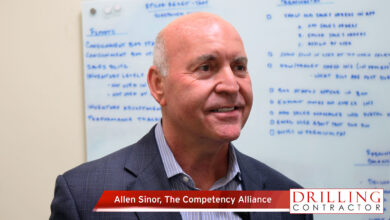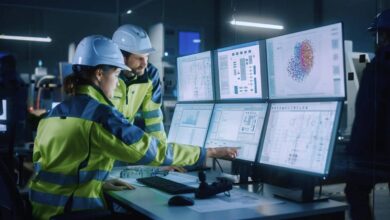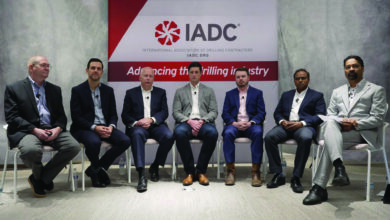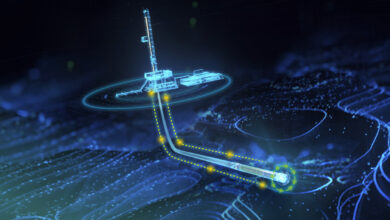Proposed industry initiative aims to increase interoperability in well construction equipment
50+ industry experts participated in April workshop and outlined vision for next steps; D-WIS group now working to identify priorities, set organizational strategy
By Darryl Fett, Total E&P Research & Technology USA
What is interoperability and why do we need it in the drilling and wells discipline? This has become a common question as the industry increasingly uses data-driven technologies, such as drilling systems automation (DSA), artificial intelligence and machine learning. Essentially, interoperability is the ability of various components from different equipment and service providers to quickly and easily connect, share high-quality data, and operate in unison as part of a holistic system with a common output.
In the well construction world, the providers of the individual components of various systems are often changed for each project. For the well construction phase, much of the equipment is rented from service/equipment providers, while some components are purchased (i.e., permanent wellbore equipment). This presents unique challenges for interoperability compared with, for example, a refinery or production platform, where components are designed, purchased, installed and operated as an integrated system.
Capabilities offered by interoperability could add significant value to the oil and gas industry by leveraging the benefits of open communication and connectivity in a similar manner to those experienced in many other industries, such as information technology, telecommunications and industrial manufacturing. These industries rely heavily on collecting, transmitting and analyzing data, then applying it to automated and semi-automated processes to achieve business objectives.
In June 2019, this topic was addressed in a presentation at the IADC Drilling Engineering Committee’s Q2 Technology Forum in Houston. It described an industry initiative called Drilling and Wells Interoperability Standards (D-WIS). The group’s objective is to establish recommended practices and standards that enable interoperability among all components, equipment and systems used in oil and gas well construction, regardless of the type or provider.
The basis for the D-WIS initiative goes back for some time, with industry groups such as the SPE Drilling Automation Technical Section (DSATS) promoting interoperability as an enabler for automation and related technologies.
The D-WIS initiative began in 2018 as an effort to consolidate the work of DSATS with that of other entities and individuals. These include Energistics, NORCE (formerly IRIS), the Operators Group on Data Quality and several DSA subject matter experts.
Since its inception, the D-WIS group has been working on a strategy and vision to develop standards, protocols, mappings, communication schemas and practices, where the various systems, equipment and components used throughout the well construction process can be connected seamlessly. The resulting ability to easily exchange data throughout the system should reduce costs, increase efficiency and improve the safety of well operations by effectively managing the collection, transfer and processing of drilling and well data, thereby maximizing its effectiveness for use in automated detection, advisory and control applications.
With interoperable components, one can imagine the capability of building a highly effective “surface and downhole” network of sensors, telemetry systems, data aggregators, analytics engines and displays that can be used in a multitude of ways to add value to the well construction process. They could also increase monitoring and diagnostics capabilities for integrity and productivity-related applications.
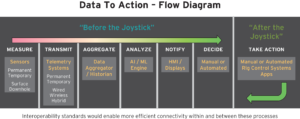
Well operations, and the many associated decisions that drive them, can be augmented with artificial intelligence and mathematical modeling using high-resolution data aggregated from this network. As a result, the time value of the derived information delivered to the decision maker is increased – regardless of whether a human, machine or a combination thereof acts on the decision.
In short, it means getting the right answer at the right time to the person or machine controlling the joystick, then taking the correct action.
Ultimately, this would lower well costs by reducing nonproductive time and invisible lost time, as well as by optimizing drilling and other operational parameters. In addition, it should also help to maximize recovery by delivering high-quality wells through repeatable performance.
During late 2018, it became apparent to the D-WIS group that the tides were changing in the drilling/wells discipline with regard to views on interoperability. Examples of interoperable systems and products – and business models – were appearing more frequently and absent any de-facto industry DSA standards. The group wanted to examine this further.
The decision was taken to organize a two-day data interoperability workshop, which was hosted by IADC in April 2019 in Houston. The main goals were to engage with the industry to identify current barriers and the desired future state of interoperability in well construction.
Over 50 industry experts representing contractors, operators, service companies, equipment providers, data modelers, data analysts and consultants joined in working groups to identify the key issues. The working groups’ findings are discussed below.
Safety/Security/Integrity
- Data interoperability will improve safety through improved monitoring and/or control of the well construction process.
- This requires safe operating procedures and safe and secure communications restricted to prevent access by bad actors.
- There must be systemic integrity, including the data used by all parties.
Quality
- Data interoperability requires quality data for meaningful analysis and control.
- Data in numerous formats are gathered from many sources.
- Data must be accurate, and its context must be well-understood.
- Calculations/algorithms that compute common parameters should be repeatable across platforms.
- A data quality assurance process should be ongoing.
Communications/Telemetry
- Data interoperability must have a trusted and reliable communications network that is easily joined by authorized participants.
- The transportation of data should be fast enough to enable proper control systems without distorting the view of the underlying processes.
- Storage and retrieval of the data should be provided in accessible locations.
Ownership/Access
- Data interoperability should recognize the ownership and the conditional use of data by various participants.
- This should be compatible with contracts, commercial interests and local laws.
- There should be a well-understood process that restricts particular data to specific locations or individuals.
Architecture/Language/Protocols
- An overall system should be designed and/or constructed with all stakeholders in mind.
- Consideration should be given to the benefits and restrictions of proprietary versus open systems and how either could meet those needs.
- The system should be fit for purpose and scalable to the different rigs in the industry and to the many end users via real time or in an archive.
- It must accommodate numerous inputs, algorithms and display techniques while protecting the ownership of such elements.
Deployment/Implementation
- A successful deployment of an interoperable system properly addresses both technical and non-technical issues.
- It involves a process to ensure that all stakeholders understand how the system operates during normal and foreseeable abnormal conditions.
- The deployment ends when all parties agree that the job was a success per specific, measurable goals.
D-WIS is building on the knowledge gained in this workshop. Steps that the group’s members are taking include: additional engagement with key industry players to identify priorities and further define technical requirements; process mapping to better understand the relationships among data generation, aggregation, processing and equipment control; and creation of a roadmap for development of standards and recommended practices.
Another key step is to identify the organizational strategy, which could include such mechanisms as a joint industry project and/or linking up with established groups involved in similar “open standards” efforts. D-WIS is also seeking input and participation from companies and individuals who believe that true interoperability and its benefits will improve the way we construct and maintain our wells. DC
For more information, please contact info@d-wis.org.

